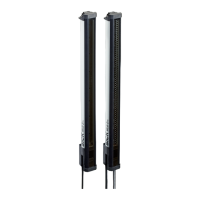Figure 7: Standard scan method
The scan time increases according to the number of beams of an MLG-2.
Figure 8: Scan time in relation to the number of beams
The scan time is used to determine the response times of the outputs, the minimum
presence time of an object and the repeat accuracy of a measurement result (reprodu‐
cibility).
•
The response time is the time it takes for an output to react following the detec‐
tion of an object/gap. The maximum response time is 3 × the scan time plus the
transmission time to the outputs.
•
The minimum presence time is the time an object or a gap has to be in the detec‐
tion area for it to be detected. The minimum presence time is max. 2 × the scan
time.
•
The repeat accuracy of a measurement result (reproducibility) is the amount of
time by which an object detection can differ from a previous or subsequent detec‐
tion. The reproducibility time is 1 × the scan time.
3.5.1 Response time, minimum presence time and reproducibility of the MLG-2
On the MLG-2, the response time, minimum presence time, and reproducibility are dis‐
played via SOPAS ET. Response time and minimum dwell time can be read off in the
diagramsee figure 129, page 122.
3.5.2 Scan time with cross-beam function
When the cross-beam function is enabled, the light beam from a sender LED is
received by three receiver diodes in two scans. This doubles the scan time.
3 PRODUCT DESCRIPTION
20
O P E R A T I N G I N S T R U C T I O N S | MLG-2 Pro 8017460.ZIK1/2017-02-13 | SICK
Subject to change without notice

